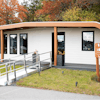In May 1996, ValuJet Flight 592 crashed in the Florida Everglades, killing all 110 onboard. The cause was determined to be 100 oxygen generator canisters that were improperly packed and mislabeled; some of those canisters were missing safety caps and most likely led to the fire that brought down the plane.
ValuJet, like most airlines, had outsourced its aircraft maintenance. The company that performed the work, SabreTech, Inc., has since gone out of business and was the first American maintenance company ever to be charged with murder.
Meanwhile, a recent study by Consumer Reports raises safety concerns about aircraft maintenance outsourcing, alleging undocumented, illegal workers at repair stations. The study contends that the FAA relies more on statistics than visual inspections.
So why do airlines still do it? Well, aircraft maintenance outsourcing got its start the way other types of outsourcing began - it was a low-cost solution.
And it’s safe.
If an air carrier wants to start performing its own maintenance work, it needs to find a facility, have inspections by the Federal Aviation Administration (FAA), get certified, and find the employees. Or, it can source the work to a company that can offer lower fixed costs and shorter turnaround times. For smaller carriers, it’s almost a necessity.
An FAA report shows that in 2000, 10 major air carriers in the U.S., including Delta and Northwest Airlines, spent more than $2.5 billion on maintenance outsourcing, accounting for nearly 30 percent of the total maintenance spending.
Larry Stenger, Director of Business Development for Jabil, a company involved with aerospace electronics, says that after 9/11, which had a dramatic impact on the industry, companies are increasingly searching for a means of reducing costs.
In the case of electronics, even small problems can turn into a serious issue in the air. Electronics must be certified to work in an aircraft environment; that certification comes from both the electronics manufacturer as well as the company that produced the airframe.
According to Terry Cobb, an associate professor of aeronautics at Embry-Riddle Aeronautical University, there are four types of aircraft maintenance: A and B are more “lube and tune” - simple operations that can be done in the field. C is more complex and D is a “massive” maintenance operation that requires taking the plane apart.
The decision on what to outsource rests with the company, but once an air carrier has decided to source maintenance work it negotiates a contract with the maintenance company. Contracts vary in length and content, but all contracts outline the timeframe that the maintenance company must adhere to. If the maintenance company violates the contract, via quality problems or longer cycle times than the contract allows, for example, the air carrier can terminate the contract.
Cobb says outsourcing maintenance poses very few safety risks. While the FAA currently requires only one licensed airframe and powerplant (A&P) mechanic on a project, that individual has gone through years of training and has extensive experience.
Ron Jordan, General Manager of Reliance Aerotech Services Inc., a staffing services company, notes that contractors are held to strict safety standards, following safety procedures and regulations outlined by each specific MRO customer.
“Maintenance, Repair and Overhaul customers (MROs) utilize contract technical specialists for a variety of reasons and within a variety of skill areas,” said Jordan. “High demand skill areas include avionics integration and structural repair. Many MROs also utilize mechanics for performance of Phase Inspections (Heavy Checks). We supply specialists for almost all conceivable skill areas within the aircraft maintenance industry.”
Jordan continued: “There is no specific guidance related to contract personnel that is materially different from an MROs direct employees. The requirements for certification/licensure, drug testing, and background checks are generally the same for both types of employees,” said Jordan. “Therefore their role within the safety program is the same as direct employees at each MRO.”
The FAA’s current requirements for mechanic certification include: a minimum of 18 months of work experience for an airframe or power-plant certificate; a minimum of 30 months of experience working with engines and airframes for a combined A&P certificate; and a minimum of 3 years with an A&P certificate, with at least 24 months of hands-on experience for an inspector’s authorization.
The FAA also requires at least 1,000 hours work experience in the previous 24 months or refresher courses to keep an A&P certification valid. A minimum of 16 hours of training every 2 years is also required.
Buyer…err outsourcer beware: the air carrier still maintains all responsibility for work that is outsourced. The FAA clearly states in written regulations on outsourcing, “The maintenance provider’s organization becomes, in effect, an extension of the air carrier’s maintenance organization. The air carrier must have the responsibility and the authority to decide what to do, when to do it and how to do it.”
ValuJet could not be reached for comment and Boeing declined to comment.






















